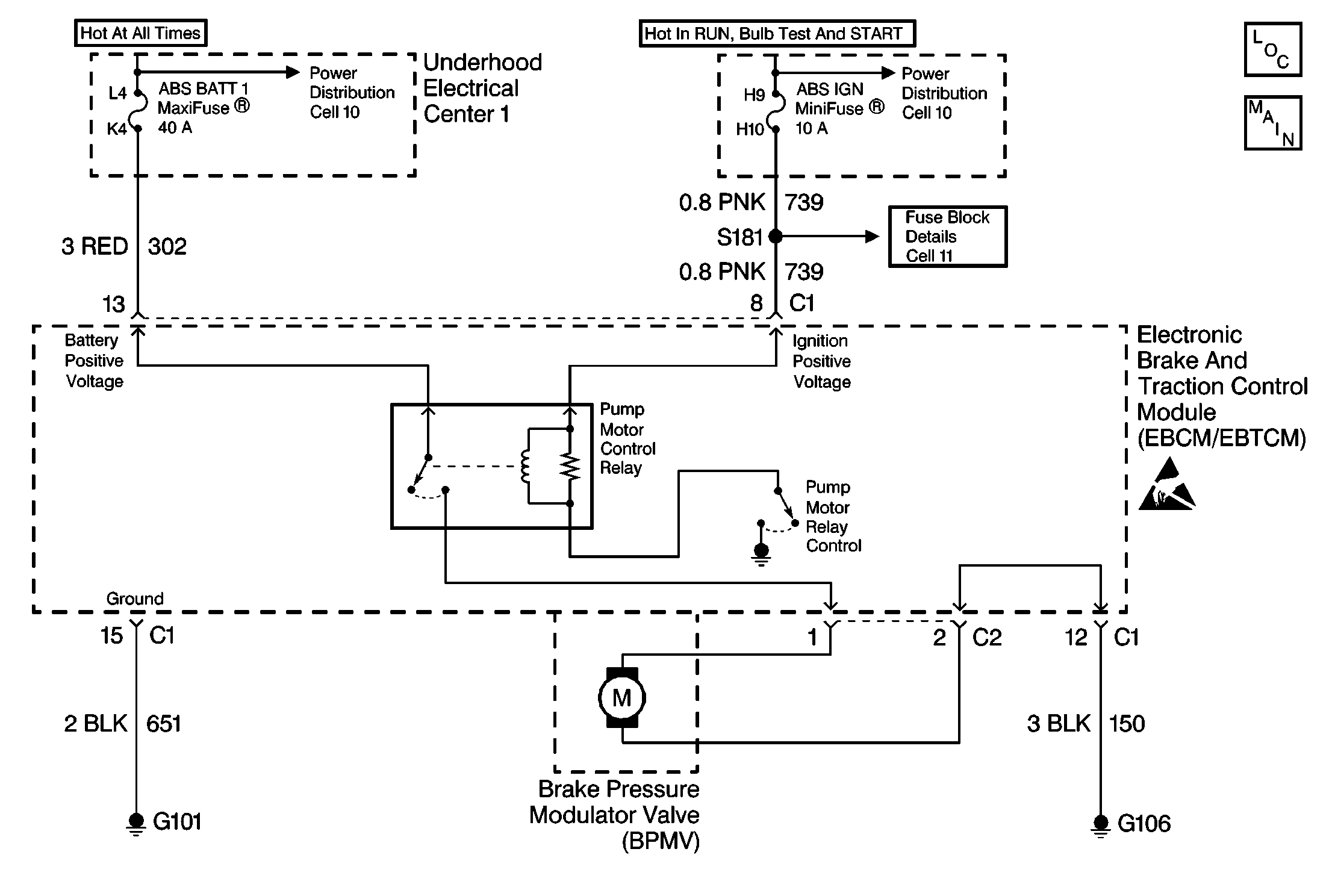
Circuit Description
The pump motor is an integral part of the BPMV, while the pump motor relay is integral to the EBCM/EBTCM. The pump motor relay is not engaged during normal system operation. When ABS or TCS operation is required the EBCM/EBTCM activates the pump motor relay and battery power is provided to the pump motor.
Conditions for Setting the DTC
| • | Pump motor voltage is not present 60 milliseconds after activation of the pump motor relay. |
| • | Pump motor voltage is present for more than 2.5 seconds with no activation of the pump motor relay. |
| • | Pump motor voltage is not present for 40 milliseconds after the pump motor relay is commanded off. |
Action Taken When the DTC Sets
| • | A malfunction DTC stores. |
| • | The ABS/TCS disables. |
| • | The amber ABS/TCS indicator(s) turn on. |
| • | The Red BRAKE Warning indicator turns on. |
Conditions for Clearing the DTC
| • | The condition responsible for setting the DTC no longer exists and the scan tool Clear DTCs function is used. |
| • | 100 ignition cycles pass with no DTC(s) detected. |
| Important: After the DTC is cleared using ignition cycle default, the vehicle must be driven above 12 Km/h (8 mph) for the ABS/TCS indicator(s) to turn off. |
Diagnostic Aids
| • | It is very important that a thorough inspection of the wiring and connectors be performed. Failure to carefully and fully inspect wiring and connectors may result in misdiagnosis, causing part replacement with reappearance of the malfunction. |
| • | Thoroughly inspect any circuitry that may be causing the complaint for the following conditions: |
| - | Backed out terminals |
| - | Improper mating |
| - | Broken locks |
| - | Improperly formed or damaged terminals |
| - | Poor terminal-to-wiring connections |
| - | Physical damage to the wiring harness |
| • | The following conditions may cause an intermittent malfunction: |
| - | A poor connection |
| - | Rubbed-through wire insulation |
| - | A broken wire inside the insulation |
| • | If an intermittent malfunction exists refer to Troubleshooting Procedures Cell 4 in Electrical Diagnosis for further diagnosis. |
Test Description
The numbers below refer to step numbers on the diagnostic table.
Step | Action | Value(s) | Yes | No |
|---|---|---|---|---|
1 | Was the Diagnostic System Check performed? | -- | Go to Diagnostic System Check | |
2 | Inspect the 40A ABS BATT 1 Maxifuse® , in the Underhood Electrical Center 1. Is the fuse OK? | -- | ||
3 |
Is the fuse OK? | -- | ||
Is the resistance within the range specified in the value(s) column? | OL (infinite) | |||
5 |
Is the fuse OK? | -- | ||
6 | Replace the BPMV. Refer to Brake Pressure Modulator Valve Replacement . Is the replacement complete? | -- | -- | |
7 |
Is the resistance within the range specified in the value(s) column? | 0-5 ohms | ||
8 | Repair CKT 150 for an open or high resistance. Refer to Repair Procedures Cell 5 in Electrical Diagnosis. Is the repair complete? | -- | -- | |
9 |
Is the voltage within the range specified in the value(s) column? | Battery volts | Go to Power Distribution Cell 10 in Electrical Diagnosis | |
Using J 39200 DMM, measure the voltage at terminal 13 of J 39700 . Is the voltage within the range specified in the value(s) column? | Battery volts | |||
11 | Replace EBCM/EBTCM. Refer to Electronic Brake Control Module Replacement . Is the replacement complete? | -- | Go to Diagnostic System Check | -- |
12 | Repair short to ground in CKT 302. Refer to Repair Procedures Cell 5 in Electrical Diagnosis. Is the repair complete? | -- | -- | |
13 | Repair open in CKT 302. Refer to Repair Procedures Cell 5 in Electrical Diagnosis. Is the repair complete? | -- | -- | |
14 |
Is the fuse OK? | -- | ||
15 |
Is the resistance within the range specified in the value(s) column? | 0-4 ohms | ||
16 |
Does the DTC reset as a current DTC? | -- | Go to Diagnostic System Check |
